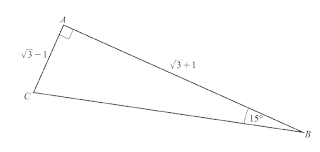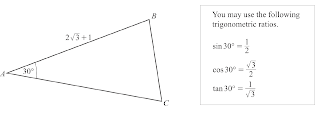| 1 | (CIE 0606/2018/w/13/q3)
Do not use a calculator in this question. In this question, all lengths are in centimetres. A triangle $A B C$ is such that angle $B=90^{\circ}, A B=5 \sqrt{3}+5$ and $B C=5 \sqrt{3}-5$.
|
| 2 | (CIE 0606/2018/w/21/q3)
Do not use a calculator in this question.
|
| 3 | (CIE 0606/2018/w/22/q7)
Solve the quadratic equation $(1-\sqrt{3}) x^{2}+x+(1+\sqrt{3})=0$, giving your answer in the form $a+b \sqrt{3}$, where $a$ and $b$ are constants. |
| 4 | (CIE 0606/2019/w/11/q8)
Do not use a calculator in this question. In this question, all lengths are in centimetres. The diagram shows the trapezium $A B C D$ in which angle $A D C$ is $90^{\circ}$ and $A B$ is parallel to $D C$. It is given that $A B=4+3 \sqrt{5}, \quad D C=11+2 \sqrt{5}$ and $A D=7+\sqrt{5}$.
|
| 5 | (CIE 0606/2019/m/12/q7)
Do not use a calculator in this question. All lengths in this question are in centimetres. The diagram shows the trapezium $A B C D$, where $A B=2+3 \sqrt{5}, D C=6+3 \sqrt{5}, A D=10-2 \sqrt{5}$ and angle $A D C=90^{\circ}$.
|
| 6 | (CIE 0606/2019/s/13/q7)
Do not use a calculator in this question. In this question, all lengths are in centimetres. The diagram shows the triangle $A B C$ such that $A B=2 \sqrt{5}-1, B C=2+\sqrt{5}$ and angle $A B C=90^{\circ}$.
|
| 7 | (CIE 0606/2019/s/21/q4)
Without using a calculator, express $\frac{(\sqrt{5}-3)^{2}}{\sqrt{5}+1}$ in the form $p \sqrt{5}+q$, where $p$ and $q$ are integers. |
| 8 | (CIE $0606 / 2019 / \mathrm{w} / 22 / \mathrm{q} 11$ )
Do not use a calculator in this question. Solve the quadratic equation $(\sqrt{5}-3) x^{2}+3 x+(\sqrt{5}+3)=0$, giving your answers in the form $a+b \sqrt{5}$, where $a$ and $b$ are constants. |
| 9 | (CIE 0606/2019/w/23/q6)
Do not use a calculator in this question.
|
| 10 | (CIE $0606 / 2020 / \mathrm{s} / 11 / \mathrm{q} 4$ )
DO NOT USE A CALCULATOR IN THIS QUESTION. Find the positive solution of the equation $(5+4 \sqrt{7}) x^{2}+(4-2 \sqrt{7}) x-1=0$, giving your answer in the form $a+b \sqrt{7}$, where $a$ and $b$ are fractions in their simplest form. |
| 11 | (CIE $0606 / 2020 / \mathrm{m} / 12 / \mathrm{q} 5$ )
DO NOT USE A CALCULATOR IN THIS QUESTION. In this question all lengths are in centimetres. The diagram shows the isosceles triangle $A B C$, where $A B=A C$ and $B C=2+4 \sqrt{3}$. The height, $A D$, of the triangle is $5-\sqrt{3}$.
|
| 12 | (CIE $0606 / 2020 / \mathrm{w} / 21 / \mathrm{q} 6)$
DO NOT USE A CALCULATOR IN THIS QUESTION. In this question all lengths are in centimetres. In the diagram above $A C=\sqrt{3}-1, A B=\sqrt{3}+1$, angle $A B C=15^{\circ}$ and angle $C A B=90^{\circ}$.
|
| 13 | (CIE 0606/2020/s/22/q2)
DO NOT USE A CALCULATOR IN THIS QUESTION. The point $(1-\sqrt{5}, p)$ lies on the curve $y=\frac{10+2 \sqrt{5}}{x^{2}}$, Find the exact value of $p$, simplifying your answer. |
| 15 | (CIE $0606 / 2020 / \mathrm{w} / 23 / \mathrm{q} 11)$
DO NOT USE A CALCULATOR IN THIS QUESTION. Solve the quadratic equation $(\sqrt{7}-2) x^{2}-4 x+(\sqrt{7}+2)=0$, giving each of your answers in the form $a+b \sqrt{7}$, where $a$ and $b$ are constants. [7] |
| 16 | (CIE 0606/2020/s/23/q5)
DO NOT USE A CALCULATOR IN THIS QUESTION.
|
Answer
1. (i) $A C=10 \sqrt{2}$
(ii) $\tan B C A=2+\sqrt{3}$
2. (a) $5 \sqrt{10}$
(b) $10 \sqrt{3}-13 \sqrt{2}$
3. $x=1+\sqrt{3}$ or $x=-\frac{1}{2}-\frac{\sqrt{3}}{2}$
4. (i) $P=22+6 \sqrt{5}+6 \sqrt{3}$
(ii) $A=65+25 \sqrt{5}$
5. (i) $10+22 \sqrt{5}$
(ii) $\frac{1}{2}+\frac{\sqrt{5}}{10}$
6. (i) $A C=\sqrt{30}$ (ii) $\tan A C B=12-5 \sqrt{5}$ (iii) $\sec ^{2} A C B=270-120 \sqrt{5}$
7. $6 \sqrt{5}-11$
8. $\quad x=3+\sqrt{5}, x=\frac{-(3+\sqrt{5})}{4}$
9. (i) $\tan A C B=2+\sqrt{3}$
(ii) $A C=2 \sqrt{6}$
10. $\quad x=\frac{6}{2 !}+\frac{1}{29} \sqrt{7}$
11. (a) $A=9 \sqrt{3}-1$
(b) $\sqrt{3}-1$
(c) $5-2 \sqrt{3}$
12. (a) proof
(b) $B C=2 \sqrt{2}$
13. $p=5+2 \sqrt{5}$
14. (a) $A C=4 \sqrt{3}-2$
(b) $B C^{2}=65-34 \sqrt{3}$
15. $x=2+\sqrt{7}, x=\frac{2}{3}+\frac{1}{3} \sqrt{7}$
16. (a) $\frac{4}{3}$
(b) $\frac{9 \sqrt{3}-15}{6}$








Post a Comment